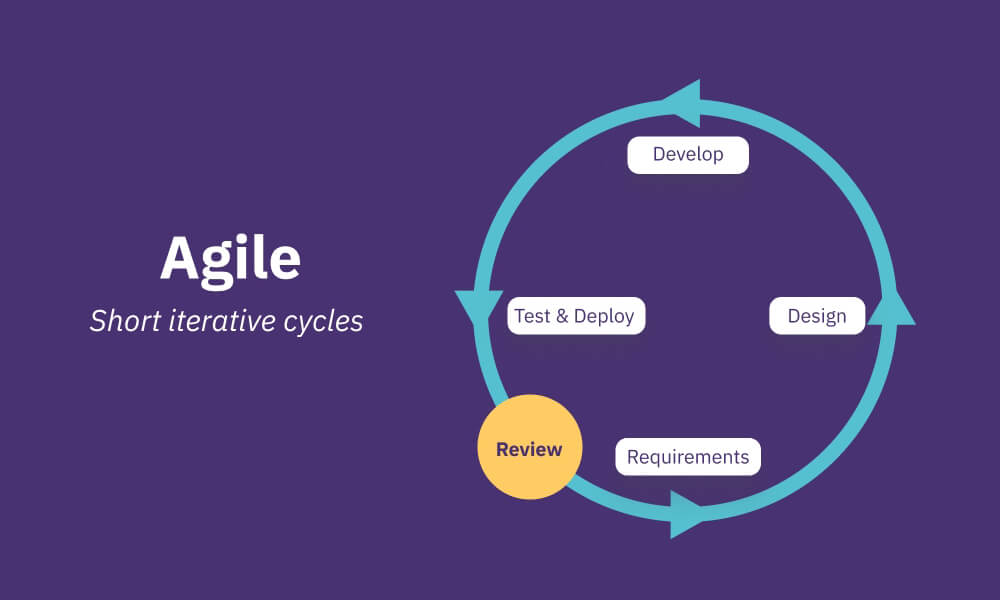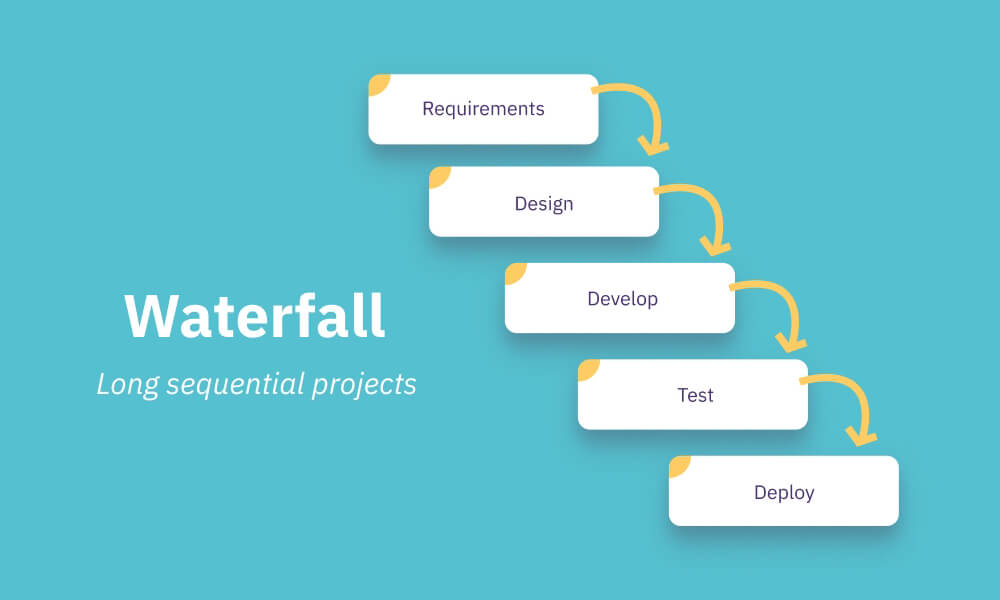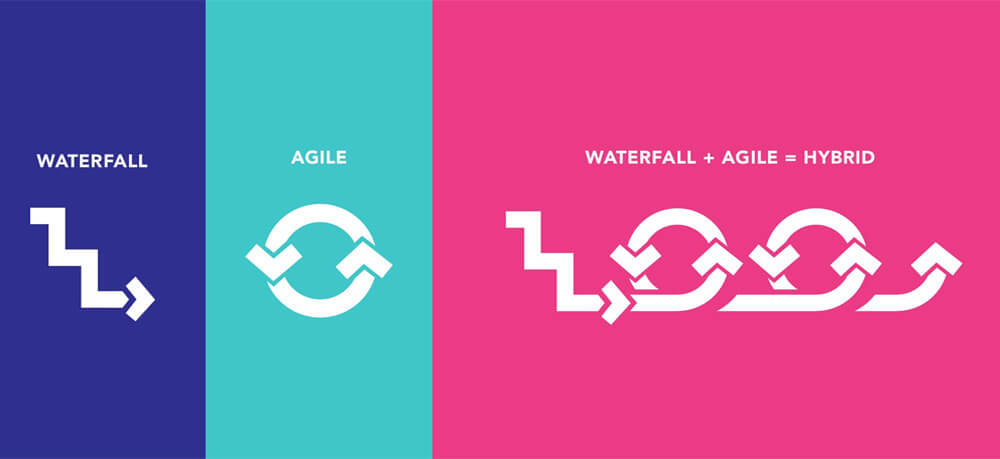Agile and Waterfall are the two most popular methodologies to manage projects, especially software-related ones. Which approach should you pick for your business? In this article, Designveloper will provide you with basic information as follows to answer this question:
- What are the pros and cons of Agile and Waterfall?
- What are the key differences between Agile vs Waterfall project management?
- What should you consider to pick up the right option?

What is the Agile Development Method?
Agile is the umbrella term that was coined to refer to fluid project management methods.
In some certain industries, a project can last months or years. But during these times, new market trends emerge and user demands also change accordingly. Therefore, companies confront the high possibility of failing products or services which hardly catch up with ever-changing user needs.

So Agile methodology was developed to help businesses promptly respond to changes in direction and requirements even late in the process. To do so, Agile teams conduct projects over an iterative agile sprint cycle of development by flexibly prioritizing and building essential features. and making frequent deliveries. They then integrate feedback from stakeholders (e.g. real customers or business people) and make frequent deliveries to meet changes.
There are various lightweight frameworks (e.g. Scrum, Kanban, or Spotify) you can apply for Agile projects. Each of the frameworks has a slightly different mechanism of action. Agile acts as a philosophy to strengthen such frameworks and make them work better in the agile world.
Today, Scrum accounts for 78% of organizations using Agile methodology, according to the 2019 KPMG Global Survey. So today, documentation and resources regarding Agile methodology are mainly revolved around 12 Agile principles and values.
Recommended reading: Agile vs Scrum Methodology: Major Differences to Consider
Pros of Agile Project Management
- Short-term deadlines allow team members to estimate which tasks they can handle within each iteration, hence encouraging their productivity and morale.
- Members are flexible to changes because Agile allows them to receive feedback and make continuous improvements.
- Time to market is expedited because teams first produce MVPs that contain the most basic features and then make frequent releases based on user responses. This also helps teams focus more on a product’s core values.
- Agile encourages communications between developers and stakeholders throughout the iteration. Accordingly, development teams can identify problems early and share work progress while stakeholders can contribute their ideas during the work.
Cons of Agile Project Management
- The project timeline is hard to define because its final outcomes depend much on market changes. If user demands continuously change, the project can last more than estimated.
- Agile has no well-defined processes or tools. So new participants in this domain may get the wrong way to become truly agile.
- Despite flexible prioritization, Agile teams can be demotivated if they miscommunicate right at the beginning and choose unnecessary features to develop.
What is the Waterfall Development Method?

Contrary to Agile, Waterfall is better suited for hands-off projects and organizations where changes are negligible. Waterfall teams often follow the sequential process of development in which documentation, expectations, and final deliverables are well-defined in the beginning.
Waterfall is the most common model of traditional project management. One noticeable feature of the Waterfall development method is that one stage’s work depends on the deliverable of the previous phase.
Recommended reading: Agile vs Traditional Project Management: Key Points in 2022
Pros of Waterfall Project Management
- Waterfall teams work on a solid project plan from scratch to end.
- Waterfall allows team members to determine clear project requirements early, hence saving time for frequent coordination.
- Having deliverables required to advance towards the next phase makes the work more systematic and structured.
Cons of Waterfall Project Management
- No modifications can intervene in the Waterfall development process. This makes development teams unlikely to adapt faster to unpredictable changes than rivals. And consequently, they may fail to satisfy end-users.
- Due to the linear nature, Waterfall teams cannot revisit a stage once it has been completed. If they want to make any adjustments, they have to come back to the first stage. This proves time-consuming and costly.
- As one stage depends on the previous one, any incurred problems (e.g. missed deadlines or technical debts) can have profound influences on subsequent deliverables. This is because they have to be completely solved so that the project can continue moving forward.
Comparison Between Agile vs Waterfall Project Management
The summary table below will give you a thorough understanding of the major differences between Agile vs Waterfall project management.
| Comparison Factors | Agile methodology | Waterfall methodology |
| Approach | Iterative | Linear |
| Scope | Any size with a well-defined scope | Small to medium scope |
| Planning | Low-level | High-level |
| Preferred organizational structure | Multi-disciplinary, self-organizing team | Hierarchical structure |
| Project timeline | Flexible because Agile teams can frequently produce improved releases of working software | Fixed |
| Approach to identify need-doing tasks | Critical Path Analysis (CPA) | Review and retrospective |
| Progress control | Burndown chart | Earned value management |
| Involvement of Stakeholders | Stakeholders (e.g. business people and customers) get involved in different iterations to provide feedback. | User feedback or the product owner’s involvement is excluded from the process until the work is completed. |
| Communications | Frequent communications through daily meetings and communication tools. Accordingly, stakeholders can contribute their ideas whereas other members can understand requirements and track their progress. | Fewer communications are required in Waterfall methodology because it involves a low level of collaboration with stakeholders. |
| Project manager (PM) roles | PMs establish plans, manage progress and follow up on tasks throughout the project. | PMs, mostly called Scrum masters, act as facilitators who clear impediments and ensure all requirements are understood to get the work done well. |
| Flexibility | High | Low |
| Budget | Flexible because it depends much on changes of direction and adaptation | Fixed because parameters and goals are clear at the beginning of the project and no additional requirements can interfere halfway |
Recommended reading: 7 Software Project Management Methodologies Besides Agile
Hybrid, the Perfect Combination of Agile and Waterfall

Project Management Institute first mentioned the term “Hybrid” when learning about how organizations selected between Agile vs Waterfall project management in 2015.
Hybrid project management is a blend of more than one methodology to plan, monitor, and execute projects. On most occasions, Hybrid is understood as the combination of Agile and Waterfall approaches. That is, it’s the process of using Waterfall methodology to conduct different project phases in which tasks will be carried out in Agile ways.
The 2019 HP online survey concluded that 24% of development and IT experts were using Hybrid for their projects. Over the past 5 years, Hybrid project management (Hybrid PM) has been developing and becoming one of the top trends in the software segment. According to the 2021 Project Management Interview of Teamhood, this methodology continues to be a common norm for some following benefits:
- Hybrid PM can be applied in projects with any scope or size;
- A project manager builds and monitors tasks. But that PM still gives team members space to be self-organized and collaborative to get jobs done during an iteration;
- Internal and external stakeholders get involved in the workflow but not daily.
Major Factors to Consider When Choosing the Right Method for You

Although Agile is on an accelerating trend, it doesn’t mean your company should adopt the methodology. Leaning towards any methodology (i.e. Agile, Waterfall, or Hybrid) without thorough consideration can accompany devastating consequences. Therefore, you should ponder several major factors to find the best option for your business:
- Are projects bound by strict requirements? In Waterfall, deliverables are required to carry out the next phase while team members need to follow a strict procedure to get jobs done on time. Meanwhile, plans and input parameters in Agile are likely to change based on stakeholders’ feedback.
- Are projects susceptible to changes? Waterfall is best suited for projects in which requirements are fixed and no significant changes can interfere. Meanwhile, Agile is mainly designed for ongoing projects or projects going through predictable changes.
- Can product owners and other stakeholders engage in the process? Agile is a customer-centric, adapt-to-change approach, so it allows frequent communications with stakeholders. Meanwhile, Waterfall shows opposite patterns.
- Do projects require high-level or low-level team coordination? Waterfall is a more methodical form of project management that determines every requirement in the beginning. So low-level team collaboration is required. Meanwhile, Agile teams need regular communications to respond faster to new situations.
In recent years, Hybrid has emerged as a new candidate in the battle between Agile vs Waterfall project management. But Hybrid PM itself has different pros and cons you factor in before deciding whether it’s the best bet for your company.
Through this article, Designveloper expects you to have a comprehensive insight into common PM solutions. The choice of suitable PM methods is of strategic significance to any company because the chosen methodology will come with your projects for a long time. So picking up the proper one requires much effort and dedication right at the beginning.
The post Agile vs Waterfall Project Management: What to Pick in 2022 appeared first on Designveloper.
April 10, 2022 at 04:45PM











No comments:
Post a Comment